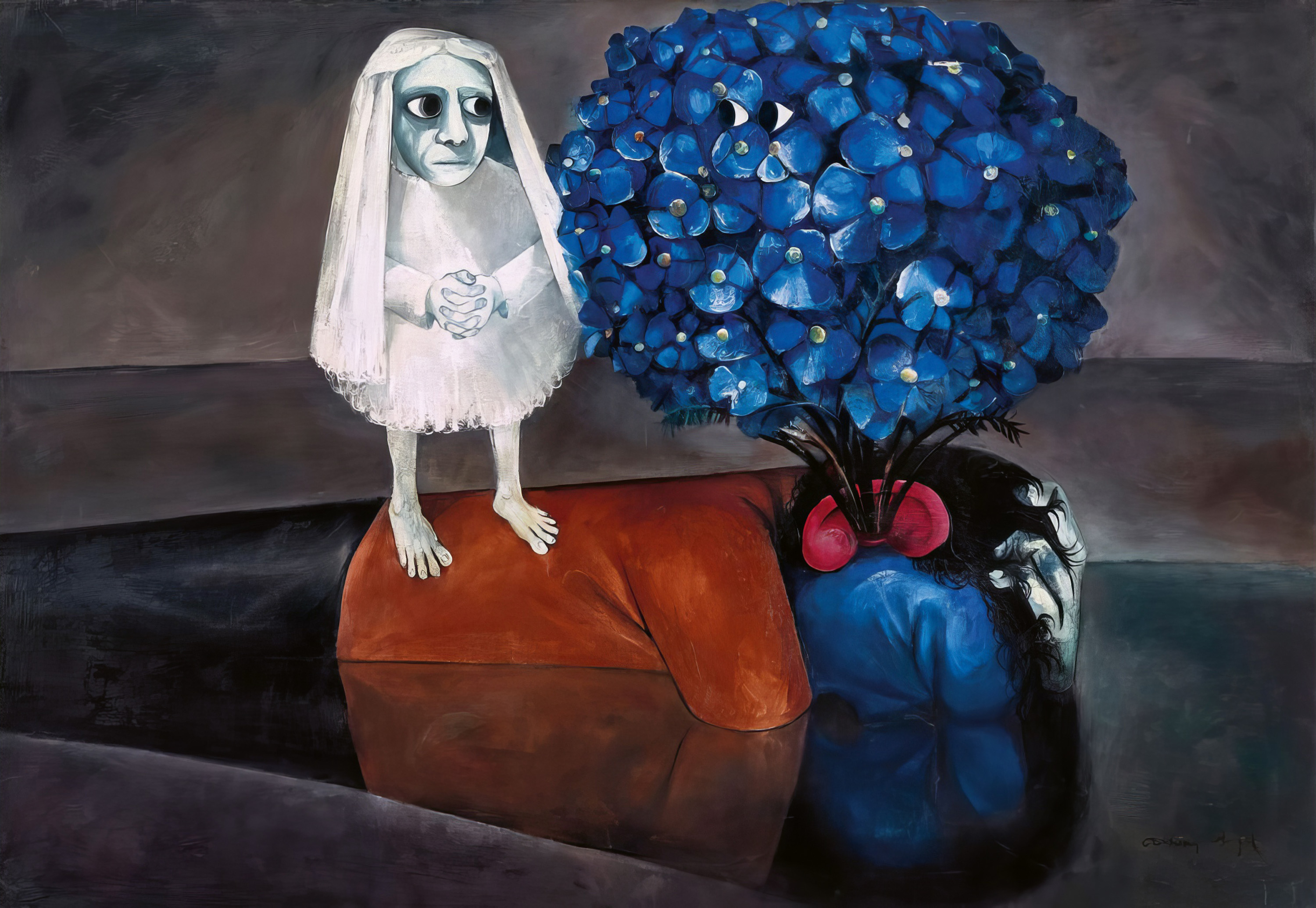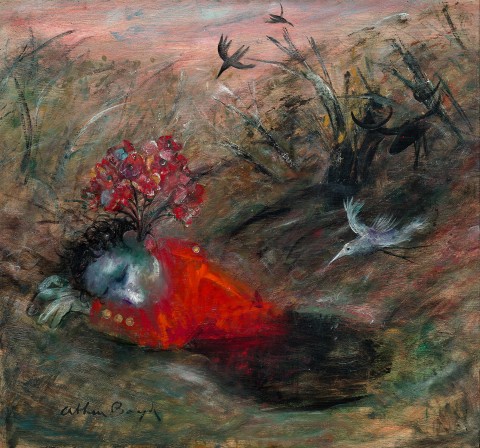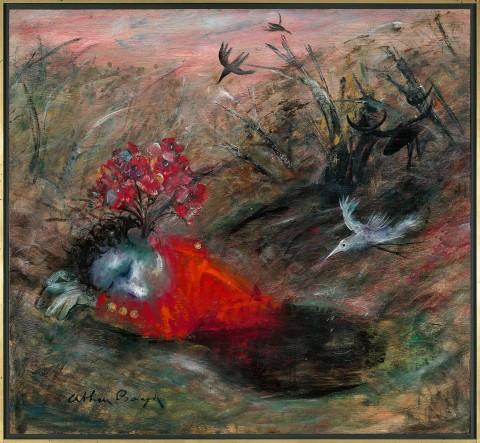SLEEPING BRIDEGROOM WITH RED BOUQUET, 1961 – 62
ARTHUR BOYD
oil and tempera on composition board
111.0 x 118.5 cm
signed lower left: Arthur Boyd
The Zwemmer Gallery, London (label attached verso, as ‘Bridegroom with a Bouquet’)
Mr and Mrs John Altmann, Melbourne by 1967
Thence by descent
Private collection, Victoria
Arthur Boyd’s Australia, National Gallery of Victoria, Melbourne, 2 April – 4 May 1970, cat. 58 (labels attached verso)
Philipp, F., Arthur Boyd, Thames & Hudson, London, 1967, cat. 10.17, pl. 96 (illus.), pp. 130, 146
250115 Boyd-(cleaned) cmyk.jpg

The son and grandson of artists, Arthur Boyd grew up surrounded by art. The family home in Murrumbeena on the eastern outskirts of Melbourne provided an encouraging environment which, as his brother, David, recalled, was fuelled by their mother’s belief that ‘the creative effort or idea was the most important thing of all… that it was related to life, it was life.’1 The recipient of several awards for art at school, Boyd was recognised for his talent from his earliest years and his passion and commitment to the creative life, from the age of about fourteen, saw him ‘go off into the landscape painting on his own… he built himself a little cart which he hitched to a pushbike, and he used to pedal around the countryside.’2
The portraits and landscapes of the 1930s – depicting people and places that Boyd knew well – were superseded in the 1940s by images that responded to the experience and atmosphere of war in a very personal way. As Robert Hughes explained, ‘the war convulsed Boyd’s arcadian plein-airism into the violent expressionistic images… To be yanked from the womb into a wartime society, with its hysterias and naked passions, shattered Boyd’s dreams of innocence.’3 Another important influence on the development of Boyd’s work during these years was Yosl Bergner, a Polish refugee who had arrived in Melbourne in 1937. With firsthand knowledge of European modernism, Bergner introduced Boyd to the work of the German Expressionists and other international artists, but the most important aspect of his influence was as an artist whose work conveyed a strong social conscience and sense of personal morality.
Boyd had hoped that a solo exhibition in 1953 would generate enough sales to fund his travel to Europe. This did not eventuate however and instead, he went to Central Australia, travelling on The Ghan to Alice Springs and then driving enormous distances to Arltunga and across the Simpson Desert.4 ‘You got a sense of it being extremely vast and much more extraordinary than I’d ever believed… You could go on thousands of miles, on and on forever.’5 It was not the landscape that affected Boyd most profoundly on this trip, but his observations of the Aboriginal population whose treatment by white Australians he found deeply distressing. The groundbreaking series of paintings, Love, Marriage and Death of a Half-Caste (also known as the Brides) grew out of this experience and although we now recognise the problematic nature of the subject-matter and Boyd’s limited understanding of the issues, it stands as a powerful testament to the empathetic humanism that underpinned his art.6
250115 boyd photo-(upscale).jpg

The first exhibition of the Brides paintings took place at Australian Galleries, Melbourne in 1958 and the following year, with guaranteed financial support (a monthly stipend from Australian Galleries exchanged for pictures), Boyd and his family sailed for England. What was initially envisaged as a stay of several months turned into years as Boyd’s international reputation and success grew. A solo exhibition at London’s Zwemmer Gallery in 1960 was followed by a major retrospective at the Whitechapel Gallery in 1962 where, of the 175 works included in the show, 70 of the largest had been made since the artist’s arrival in London just a few years earlier. Inspired by his surroundings and buoyed by the interest in his art, Boyd was energised and producing some of the boldest and most confident painting of his career. Critics responded enthusiastically to the Antipodean flavour of his imagery but also recognised its allegiance to the traditions of European art. Indeed, it was Boyd’s access to the work of the masters that he had previously only known through reproduction (Titian, Tintoretto, Goya and Rembrandt among many others) that helped fuel this period of intense creativity. In addition to Boyd’s habit of borrowing elements from Old Master paintings he saw, Ursula Hoff identified the increased eclecticism of his approach during these years as well as a more sophisticated handling of paint.7
We see this in Sleeping bridegroom with red bouquet, 1961 – 62 where the brushstrokes, deft and assured, also reveal a distinct lightness of touch. The translucency of tempera (traditionally made by combining pigment with egg yolk and here, used in combination with oil paint) allows us to see the way colour is progressively built up to define form and construct the landscape. Lying in a shallow gully surrounded by dense vegetation, the figure is dreaming and still while all around him is movement, as trees and grasses sway and swirl in the wind and birds swoop through the air. His red jacket with its gleaming gold buttons distinguishes the bridegroom from the natural surroundings, but half submerged in a dark pond, he is depicted ‘sinking back into the cycle of nature.’8 Boyd’s signature iconography is here, from the red-eyed ramox, a personal symbol of lust, fear and guilt, to the ‘dream-posy’ which sprouts joyously, if rather incongruously, from the bridegroom’s ear.9
The 1960s was Boyd’s ‘decade of triumph’, the period in which he established a reputation – both internationally and in his country of birth – as an artist whose skill and creative drive matched the brilliance and originality of his imagination. Sleeping bridegroom with red bouquet reflects the dynamism of this moment, looking back to one of the landmark series of Boyd’s oeuvre and signalling the brilliant and singular career that was to come.
1. David Boyd cited in Pearce, B., Arthur Boyd Retrospective, Art Gallery of New South Wales, Sydney, 1993, p. 11
2. ibid.
3. Hughes, R., ‘Nolan and Boyd’, Nation, 4 April 1964, cited in Pearce, op. cit., p. 14
4. See Morgan, K., Arthur Boyd Brides, Heide Museum of Modern Art, Melbourne, 2014, p. 11 and Pearce, ibid., p. 20
5. Boyd cited in Pearce, ibid., p. 20
6. For a discussion of the Brides series from a twenty-first century perspective, see essays by Kendrah Morgan and Marcia Langton in Morgan, K., Arthur Boyd Brides, Heide Museum of Modern Art, Melbourne, 2014
7. Hoff, U., The Art of Arthur Boyd, Andre Deutsch, London, 1986, pp. 22 – 23
8. Philipp, F., Arthur Boyd, Thames and Hudson, London, 1967, p. 261, cat. 10.17
9. See Morgan, op. cit., p. 16 and Philipp, ibid.
KIRSTY GRANT


